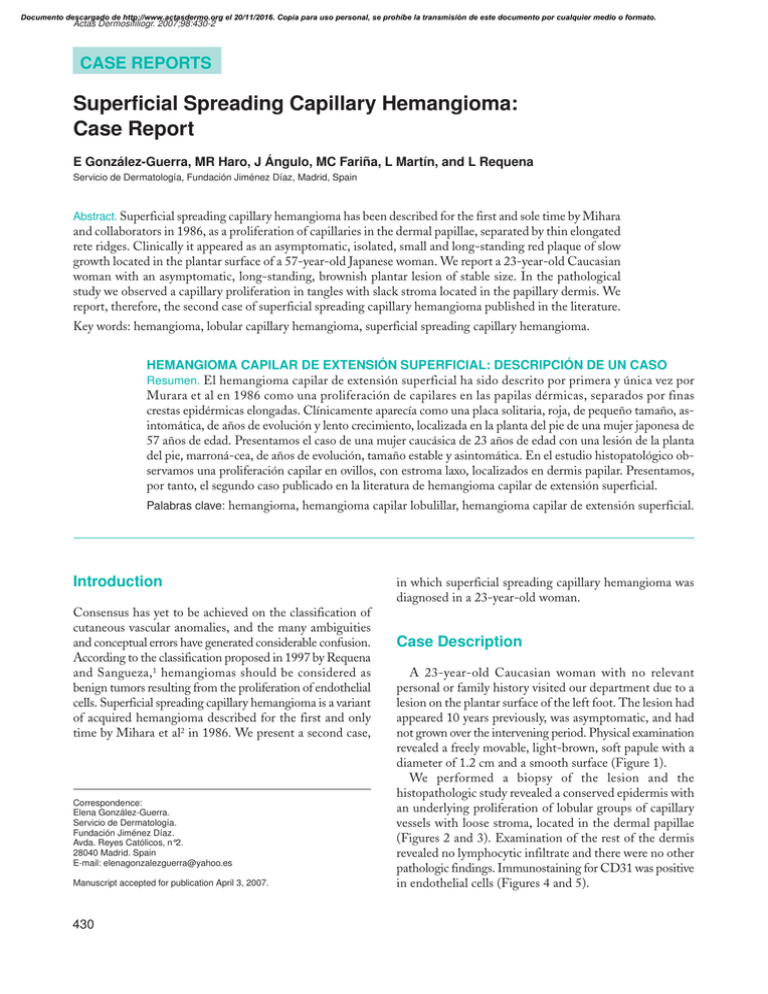Superficial Spreading Capillary Hemangioma: Case Report
Anuncio

Documento descargado de http://www.actasdermo.org el 20/11/2016. Copia para uso personal, se prohíbe la transmisión de este documento por cualquier medio o formato. Actas Dermosifiliogr. 2007;98:430-2 CASE REPORTS Superficial Spreading Capillary Hemangioma: Case Report E González-Guerra, MR Haro, J Ángulo, MC Fariña, L Martín, and L Requena Servicio de Dermatología, Fundación Jiménez Díaz, Madrid, Spain Abstract. Superficial spreading capillary hemangioma has been described for the first and sole time by Mihara and collaborators in 1986, as a proliferation of capillaries in the dermal papillae, separated by thin elongated rete ridges. Clinically it appeared as an asymptomatic, isolated, small and long-standing red plaque of slow growth located in the plantar surface of a 57-year-old Japanese woman. We report a 23-year-old Caucasian woman with an asymptomatic, long-standing, brownish plantar lesion of stable size. In the pathological study we observed a capillary proliferation in tangles with slack stroma located in the papillary dermis. We report, therefore, the second case of superficial spreading capillary hemangioma published in the literature. Key words: hemangioma, lobular capillary hemangioma, superficial spreading capillary hemangioma. HEMANGIOMA CAPILAR DE EXTENSIÓN SUPERFICIAL: DESCRIPCIÓN DE UN CASO Resumen. El hemangioma capilar de extensión superficial ha sido descrito por primera y única vez por Murara et al en 1986 como una proliferación de capilares en las papilas dérmicas, separados por finas crestas epidérmicas elongadas. Clínicamente aparecía como una placa solitaria, roja, de pequeño tamaño, asintomática, de años de evolución y lento crecimiento, localizada en la planta del pie de una mujer japonesa de 57 años de edad. Presentamos el caso de una mujer caucásica de 23 años de edad con una lesión de la planta del pie, marroná-cea, de años de evolución, tamaño estable y asintomática. En el estudio histopatológico observamos una proliferación capilar en ovillos, con estroma laxo, localizados en dermis papilar. Presentamos, por tanto, el segundo caso publicado en la literatura de hemangioma capilar de extensión superficial. Palabras clave: hemangioma, hemangioma capilar lobulillar, hemangioma capilar de extensión superficial. Introduction Consensus has yet to be achieved on the classification of cutaneous vascular anomalies, and the many ambiguities and conceptual errors have generated considerable confusion. According to the classification proposed in 1997 by Requena and Sangueza,1 hemangiomas should be considered as benign tumors resulting from the proliferation of endothelial cells. Superficial spreading capillary hemangioma is a variant of acquired hemangioma described for the first and only time by Mihara et al2 in 1986. We present a second case, Correspondence: Elena González-Guerra. Servicio de Dermatología. Fundación Jiménez Díaz. Avda. Reyes Católicos, n°2. 28040 Madrid. Spain E-mail: elenagonzalezguerra@yahoo.es Manuscript accepted for publication April 3, 2007. 430 in which superficial spreading capillary hemangioma was diagnosed in a 23-year-old woman. Case Description A 23-year-old Caucasian woman with no relevant personal or family history visited our department due to a lesion on the plantar surface of the left foot. The lesion had appeared 10 years previously, was asymptomatic, and had not grown over the intervening period. Physical examination revealed a freely movable, light-brown, soft papule with a diameter of 1.2 cm and a smooth surface (Figure 1). We performed a biopsy of the lesion and the histopathologic study revealed a conserved epidermis with an underlying proliferation of lobular groups of capillary vessels with loose stroma, located in the dermal papillae (Figures 2 and 3). Examination of the rest of the dermis revealed no lymphocytic infiltrate and there were no other pathologic findings. Immunostaining for CD31 was positive in endothelial cells (Figures 4 and 5). Documento descargado de http://www.actasdermo.org el 20/11/2016. Copia para uso personal, se prohíbe la transmisión de este documento por cualquier medio o formato. González-Guerra E et al. Superficial Spreading Capillary Hemangioma: Case Report Figure 1. Erythematous papule on the plantar surface of the left foot. Figure 3. Detail of proliferation of capillary vessels grouped in lobules, with loose stroma (hematoxylin-eosin, ×40). Figure 2. Capillary vessels grouped in lobules in the dermal papillae (hematoxylin-eosin, ×10). Figure 4. Detail of proliferation of capillary vessels (immunostaining for CD31). Based on these findings, we established a diagnosis of superficial spreading lobular capillary hemangioma. Discussion Mihara et al2 described superficial spreading capillary hemangioma as a proliferation of capillary vessels in the dermal papillae, separated by thin, elongated epidermal ridges. Clinically, the hemangioma appeared as a small, isolated, red plaque on the plantar surface of the foot. It was asymptomatic, long-standing, and displayed slow growth. The patient was a 57-year-old Japanese woman with a history of breast cancer. The patient described here showed similar clinical and histological characteristics to those of the above case. Figure 5. Immunostaining for CD31 showing positive endothelial cells. Actas Dermosifiliogr. 2007;98:430-2 431 Documento descargado de http://www.actasdermo.org el 20/11/2016. Copia para uso personal, se prohíbe la transmisión de este documento por cualquier medio o formato. González-Guerra E et al. Superficial Spreading Capillary Hemangioma: Case Report From a histopathologic perspective, differential diagnosis should mainly consider stasis dermatitis and Mali acroangiodermatitis, which tends to occur in the distal regions of the legs of elderly patients as a result of chronic venous insufficiency. Histological studies of the chronic phase of stasis dermatitis tend to show psoriasiform epidermal hyperplasia, whereas the epidermis was conserved in our patient. The dermis of patients suffering from stasis dermatitis contains dilated capillary vessels with prominent, globular endothelial cells, deposits of hemosiderin, and hyperplastic and sometimes thrombotic venules. In the final stages, fibrosis of the dermal connective tissue and sclerosis of the subcutaneous cellular tissue occur with development of a process known as sclerosing panniculitis or lipodermatosclerosis. This process alters the shape of the distal third of the affected leg, making it look like an inverted champagne bottle. In superficial spreading capillary hemangioma, however, we only found thin-walled, dilated capillary vessels grouped in small lobules in the dermal papillae, with no other pathological findings. 432 To conclude, superficial spreading capillary hemangioma is a variant of acquired hemangioma that, based on the clinical characteristics of the 2 cases now described in the literature, appears to present a particular affinity for the plantar surface of the feet. Its clinical behavior is wholly benign and simple resection appears to cure the condition. Conflicts of Interest The authors declare no conflicts of interest. References 1. Requena L, Sangueza OP. Cutaneous vascular anomalies. Part I. Hamartomas, malformations and dilatation of preexisting vessels. J Am Acad Dermatol. 1997;37:523-49. 2. Mihara M, Kambe N, Shimao S. Superficial spreading capillary hemangioma. A peculiar type of capillary hemangioma. Dermatologica. 1986;172:116-9. Actas Dermosifiliogr. 2007;98:430-2








